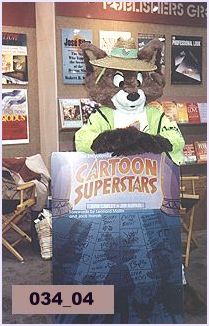cataroo.com
Home of John Cawley
Dedicated to My Wife & Times - A Site for Sore Eyes
Back To Archives
Back To Main Page
|
Frames of Time... 034_04 - A Fox at the ABA Jim and I had been hanging together for a number of years, having met through the apa Apatoons. Oddly, we lived only a few miles from each other the whole time but it took an out of state friend's visit to get us together. Once together, we found we had lots of things in common, perhaps first amongst them was a love of animation. We began a number of ventures that were mutually advantageous. We had tables at a number of San Diego Comic Cons selling bits and pieces from our collections. We tried starting up a mail order venture specializing in books and videos featuring only animation. Called "Korkis and Cawley's Cartoon Corner", it was most noted for the wonderful caricature art created by animation artist Dave Bennet. After several years we dropped the idea, though we did give advice to a more cash-based individual who started up the Cartoon Catalogue. We then began a series of columns for various publications. The goal was that we would be spotted by a famous publisher and offered tons of money to write books. Instead, we found Pioneer Books, a budget-publishing house specializing in quickie books often tied to cult media or collectibles. Jim made the initial connection. We agreed to start with two books. One was to be a "how to" book, the other a general animation book. Our initial idea was that since so many animation books were centered on artists or studios, of whom the general public had little recognition, we would base our book on the stories of actual cartoon characters, of which almost everyone knew. We came up with the title of "Cartoon Superstars". The publisher insisted we add the "Encyclopedia of..." since the "E" word would mean more sales to schools and libraries. We began assembling lists of who would be in the book. This proved to be more difficult than originally thought. If we only used Disney and Warner Bros characters, we would easily fill our quota of 25. (The number was based on the book length.) We then started a rigorous listing and re-listing making the final group cover TV and theatrical as well as as many studios as possible. When we came up with the final list, only two were questioned by the publisher. One was the TEENAGE MUTANT NINJA TURTLES, to represent modern syndicated animation. The second was THE SIMPSONS. The publisher felt the FOX series was too new and might not last. For the writing process, Jim and I had devised a system that we would split the book, each writing a first draft for half the chapters. We would then switch and do second drafts on the other's first. We had found this worked well with the previous columns. We did a tremendous amount of research. Not only did we utilize our extensive libraries of clip files and interviews, we even went back and watched many of the cartoons again. (This allowed us to spot a number of errors in then current animation books, causing us, on more than one occasion, to explain why our book had a different fact/story.) After the writing came the illustrations. Not wanting to use the standard movie stills found in other books, we went into our collections and found comics, toys, advertisements, production art and more. Much of it we had to photograph ourselves, which took a number of days and quite a lot of expense. (This was back in the days of 35mm film and developing costs.) After months of work, we put it together and shipped it to the printer. Our months of research, writing, photographing, and captioning paid off. We had The Encyclopedia of Cartoon Superstars in our hands. I figured at the rate we were paid by the publisher, we probably would have made more working the hours at McDonald's. The books were to debut at the annual American Booksellers Association (ABA) convention in Las Vegas. The publishers asked if we wanted to come out and promote the book. Though Jim had to work, I took time off and headed to Vegas. Once there, I surprised the publishers with my fox costume. Thrilled at the extra publicity value, they had me parade around the convention site with flyers on our books. I'm not sure if my attendance helped sell the books, but it certainly gave me a chance to learn about the book business. I discovered that our meager pay was fairly common to most small publishers. In fact, at the time, most small presses only published around 10,000 copies per book. That meant if each of the 50 states bought 200 copies the book, it would sell out! Shockingly, few such small press titles sold out. After Jim and I had written around a half-dozen books, we suddenly found that big publishers were not going to come after us for books. We also found that when we approached larger publishers with ideas, we were politely rejected. (On occasion some of book proposals came out later under bigger name authors.) The entire process made me forever think differently about books, and allowed me to understand how so many published authors still had full time jobs.
Back To Archives Back To Main Page |
 In 1990, I entered the world of James Thurber, Ray Bradbury and Bob Thomas. I was a published author of a book. Jim Korkis and I had begun a brief career co-writing books about animation.
In 1990, I entered the world of James Thurber, Ray Bradbury and Bob Thomas. I was a published author of a book. Jim Korkis and I had begun a brief career co-writing books about animation.